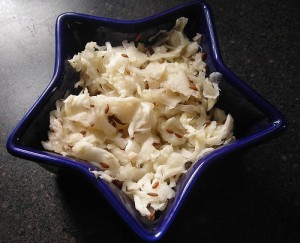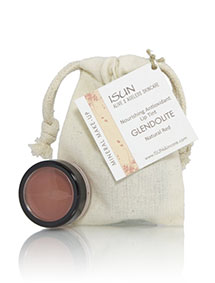What is Fermentation?
Vegetable fermentation is a natural process of using lactic acid bacteria for fermentation. Cabbage is the best vegetable to ferment, because it has copious amounts of lactic acid bacteria.
The Health Benefits of Fermented Foods
Fermented foods aid in digestion, support immune function, stop cravings for sugar and carbohydrates in processed foods, contain B vitamins and anti-inflammatory omega-3 fatty acids, can help to reduce high cholesterol levels in our blood, and increase the ability to absorb nutrients in your foods by up to one hundred times. Consuming foods that contain live lacto-bacteria has protective benefits against pathogenic microorganisms, aiding our bodies into fighting and preventing diseases, such as cancer. All of these health benefits also have a significant affect on the beauty and youthfulness of your skin!
Make Your Own Sauerkraut
Making your own sauerkraut is fun and easy! Most commercial sauerkraut is pasteurized, thus killing the beneficial flora (except for a few brands like Rejuvenative). Jed and I recently made two batches. One turned out just right and was so delicious, it was all I wanted to eat for days. The other batch went bad and was a total wash. We prepared both batches exactly the same and used the same jars for both. It is helpful to keep in mind that fermentation is more of an art than a science. They are so many factors, even uncontrollable ones, that can affect the fermentation process. Being free of an attachment to the outcome is a good idea, just in case it does not not turn out the way you hope. I have found that the more practice I have with fermenting, the more I increase my chances of success. Once you get down the timing, the measurements, the jars, the tools, the ingredients that work for you, delicious results become much more likely.
The Recipe
Container & Tools:
a glass or ceramic jar (no plastic! it will leach into your food)
I like to eat the sauerkraut as a snack or meal, instead of as a condiment, since I love it so much, so I use large jars to make a large quantity.
a wooden spoon with a long handle (metal will kill the friendly bacteria)
Ingredients:
1/4 – 1 full head of Organic Cabbage depending on how much you desire
4-5 tablespoons per quart of Organic, Raw, Unfiltered Apple Cider Vinegar
2 tablespoons per quart Himalayan Crystal Salt or Celtic Sea Salt (Using salt in the process prevents the breakdown of vegetable proteins and the overgrowth of yeast.)
The most pure Water possible, water directly from a natural spring that you have collected yourself, or Artesian well water is the ideal choice. Do NOT use chlorinated tap water! The chlorine will kill the friendly bacteria you are trying to cultivate.
Instructions
- Wash your hands (the environment should be as sterile as possible).
- Choose a clean, sterile jar or jars to ferment in.
- Chop the cabbage into whatever size pieces you desire. Chopping it in a food processor will yield more condiment size pieces. Place the cabbage in the jar.
- Add the Apple Cider Vinegar and the Salt to the jar and then fill the jar with water so the cabbage is covered by at least an inch of water.
- Use a sterile wooden spoon to mix the cabbage, salt, vinegar, and water together. I use the handle of a long wooden spoon to mash everything together. The spoon part is too big to get through all of the fairly tightly packed cabbage in the jar.
- Seal the jar – not too tightly. A jar that is sealed too tightly could result in an explosion.
- Place the jar in a dark place. I use a low kitchen cabinet. The closer to the floor the cabinet is, the more stable the temperature will be. The average household temperature is fine for fermentation (68-72 degrees).
- Check on the sauerkraut in about 5 days. If a scum forms on the surface, do not fret, it should only affect the surface. Remove the scum if it does form and make sure the cabbage underneath is unaffected. Taste the sauerkraut. It should start to be sour and tangy after a few days, and should get stronger with time. In cool temperatures, the fermentation process could continue for weeks or months. In warmer temperatures the process is far more rapid and could be ready in a week or so. You instinctively know whether a food has gone bad or is delightfully tangy and fermented. Use your amazing senses to determine when you would like to eat it! To stop the fermentation process, place the saurkraut in the refridgerator. It will last for months in the fridge.
Tip: Food Grade Hydrogen Peroxide is an instant, easy, and effective sterilizer.
Experiment with fermentation and glow with health and beauty! Enjoy!






[…] and eat lacto-fermented vegetables (such as sauerkraut, kimchee, pickles, and sauerkraut). Make your own or look for the brand Rejuvenative Foods at your health food store. You can also wash your mouth […]